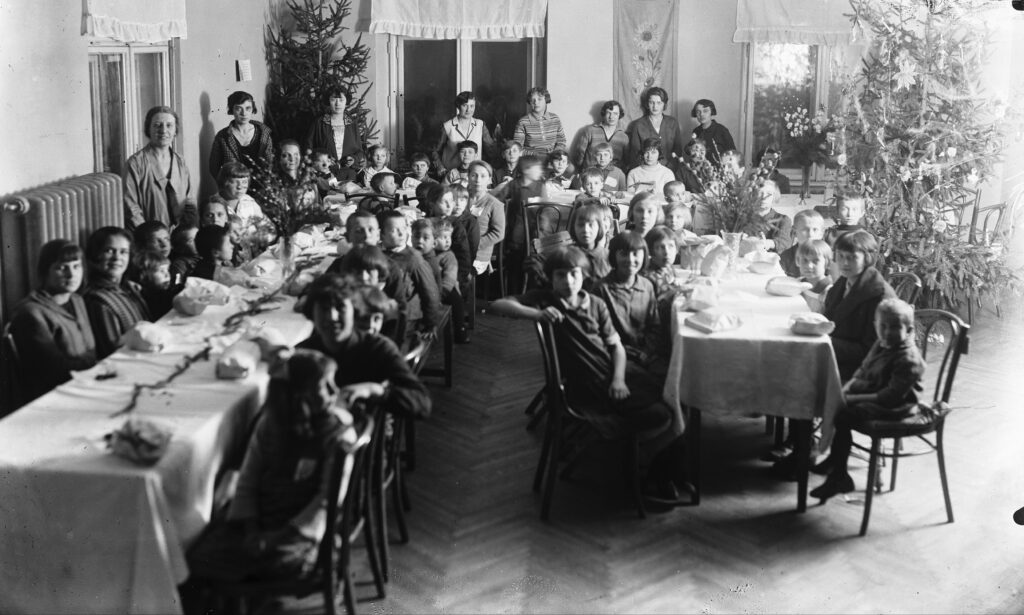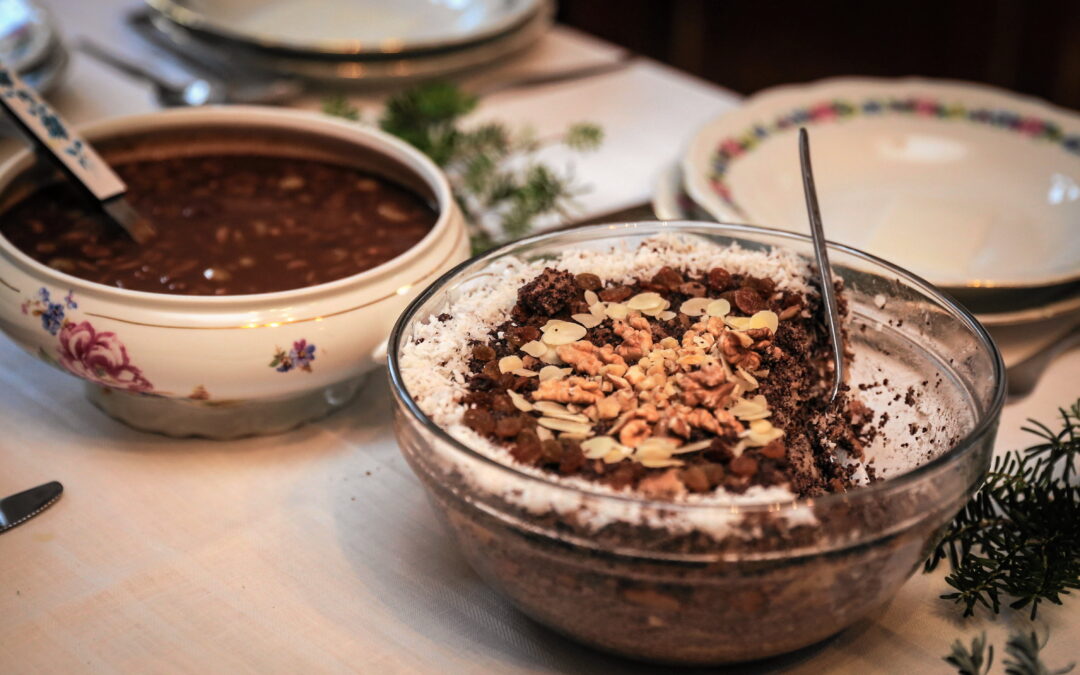By Natalia Parzygnat
As Christmas approaches, each Polish family will have its own traditions and preferences for what dishes to prepare for the traditional Wigilia supper on 24 December. Most will agree, however, that there should be 12 of them, including certain “must have” elements.
But the Polish Christmas table is in fact a very moveable feast. Tastes and availability have shifted over the decades and centuries and a wealth of regional differences persist today. Meanwhile, new variations have sprung up to cater for changing dietary requirements. Even the rule about the number of dishes is being challenged, with studies showing most Poles are opting for fewer.
Centuries of Polish Christmas tables
The 12 dishes traditionally served on Christmas Eve symbolise the months of the year or 12 apostles. Trying and tasting all of them – from the savoury wild mushrooms, beetroot soups and sour cabbage stews to the sweet honey-laced poppyseed desserts and gingerbread – is said to bring luck. But this number only became fixed after the Second World War.

Christmas Eve supper for poor children organised by the Young Polish Women’s Society in Kraków, 1927 (photo: public domain/Szukajwarchiwach)
Before the 19th century, in fact, most households chose odd numbers, usually five, seven or nine. And the number often depended on families’ economic situation – aristocrats would often serve 11 dishes.
As they do today, Polish Christmas suppers would feature meatless dishes, owing to the continued Catholic fast. Key ingredients included boiled vegetables, such as cabbage, yellow and black carrots, radish and parsnip, as well as fish, according to the Encyclopedia of Polish Tradition by Renata Hryń-Kuśmierek and Zuzanna Śliwa.
Historical accounts of a feast eaten by 17th-century Polish king Jan III Sobieski included a wealth of fish available from the Baltic Sea as well as Poland’s rivers and lakes, including salmon, carp, pike, and herring. These would be accompanied by rice and almonds, olive oil and eggs, as well as a large serving of snails.
I adore the colourful and chaotic patchwork of dishes that the whole family brings to the Christmas table.
(This year’s cold medley has five herring varieties, carp aspic, salmon tartare, cooked vegetable salad, spiced pears in vinegar, wild mushrooms, poppyseed & cherry cake) pic.twitter.com/g2Izz0Tt8F
— Maria Wilczek (@mariawilczek) December 24, 2020
Some well-known dishes of bygone times have now disappeared from Polish tables. These include the Sarmatian dish of pike in wine sauce and a popular almond soup, says Magdalena Tomaszewska-Bolałek, head of food studies at the University of Social Sciences and Humanities (SWPS).
By the early 20th century, a cookbook by Antoni Teslar featured ingredients that have become part of the Christmas repertoire today: a saffron-laced fish soup with pike; carp garnished with lemon, raisins and red wine; and poppy seed strudel. Borscht, a sour and peppery beetroot broth served with dumplings that continues to be a festive staple today, was already becoming popular.
The food shortages, high prices and ration-card system that the communist period brought sparked a new form of creativity in family kitchens. A recipe for borscht printed in 1984 by Przyjaciółka women’s magazine features a broth of pork bone and marrow when meat was scarce.
For many Poles, memories of Christmas are infused with the scent of lemons, tangerines and oranges, a rarity in socialist Poland that would be imported once a year for the occasion amid much media fanfare. Magazines such as Kobieta i Życie note that wild mushrooms, nuts and dried fruits had become the preserve of the rich.
Another dish that became a mainstay in this period and still takes pride on many a Wigilia table is carp. Once predominantly a Jewish delicacy, the fish started to be mass-produced amid a sea fish shortage after the Second World War. Hilary Minc, Poland’s industry minister in 1947, promoted it as a Christmas custom by handing out carp rations as a festive bonus in workplaces.
A map of Polish specialities
Today’s Christmas dinner usually opens with cold plates, including varieties of soused herring, followed by borscht or mushroom soup, and then the hot dishes: often carp, pierogi stuffed with sauerkraut and mushrooms, and croquettes. Dessert usually comes as gingerbread, poppy seed cake, kutya or sour cheesecake.
While most Poles agree on the basic Christmas palette, regional differences persist even among dishes with the same basic ingredients.
“Borscht itself…is prepared differently in many houses,” says Tomaszewska-Bolałek. In the eastern region of Podlasie the soup is made with cooked beets and seasoned with lovage leaves, while elsewhere a fermented beetroot base is common.
Some regions have also developed their own historical specialities. Silesia has “siemieniotka”, a creamy soup made of hemp seed, and “moczka”, a gingerbread with dried fruit, nuts and soaked in dark beer.
In the mountainous southern region of Podhale people eat a vegetarian version of “kwaśnica”, a sour cabbage soup with potatoes. Meanwhile those from the eastern city of Lublin feast on “kulebiak”, a savoury strudel filled with cabbage.
Nice effort to map all the regional shades of the 12-dish Christmas Eve extravaganza in #Poland, on @BIQdata.
Beyond poppyseed, beetroots and wild mushrooms, it looks like the smoky mix of dried pears, plums and apples ("susz") is what unites Poles. https://t.co/zDutmg8prV pic.twitter.com/QADLxATBwB
— Maria Wilczek (@mariawilczek) December 22, 2020
Marcin Popielarz, a chef, tells Notes from Poland that in his family home “culinary delights of various cultures intertwined” as his grandmother’s borderland cuisine combined recipes from Ukraine and Belarus.
“I remember well the taste of dumplings with buckwheat and mint, and those with cut cabbage and mushrooms,” he says. Today these flavours feature on the Christmas menu at his White Rabbit restaurant in Gdynia. Other dishes include herring with potato purée, mushroom cream soup, and cod with buttermilk and dill.

A vegan mushroom consommé with black truffle and lovage oil from White Rabbit restaurant (photo: Restauracja Biały Królik)
New diets and fads
The Polish Christmas set also continues to evolve as dietary preferences and restrictions increasingly shape festive cooking. “Some dishes are no longer attractive to us in terms of taste, flavour or calories,” says Tomaszewska-Bolałek.
A traditional Christmas feast does not include meat, even though the Catholic church no longer requires strict fasting on Christmas Eve and Catholic canon law allows eating meat. Many still stick to old rules, but now greater numbers are also cutting down on fish and dairy products.
New research by Kantar shows that 31% Poles are planning to modify their dinner to a specific diet this year. Most commonly they are opting for vegetarian (17%) and low-glycemic meals (11%). Many also choose to have lactose-free, vegan, and gluten-free dishes (5% each).
Radosław Bartkowiak, who manages Vega, a vegan restaurant in Wrocław, says that customers also include many non-vegans looking for variety in their diets, and that he also caters to customers with other requirements such as gluten-free and diabetic diets.
“There is a third group, or those who perceive vegan cuisine as a healthier alternative,” he explains.
Top sellers include non-fish fillets made from red lentils and traditional stuffed cabbage rolls with buckwheat, as well as pierogi with tofu in lieu of cottage cheese filling, says Bartkowiak.
“Every year we try to surprise guests with something new,” he says. This year’s dessert sensation is a poppy seed sponge with coconut cream.
Moreover, as some Poles chose to dine out around Christmas, many restaurants now offer sophisticated takes on familiar dishes. White Rabbit offers veal-based borscht laced with “aromatic pickled hibiscus” and a vegan mushroom consommé with black truffle and lovage oil. The latter, Popielarz says, is also becoming popular also with omnivorous guests.
An upmarket restaurant in Warsaw, Bez Gwiazdek, serves tasting menus based on the ingredients and techniques endemic to a different region of Poland each month. In December they instead offer a Christmas take – in both regular and vegetarian form.
This year’s menu includes borscht with strawberries and marjoram as well as herring served with apple, kohlrabi, buttermilk. Their pierogi come with goose leg meat and a mushroom broth, and are paired with regional wines.
A more modest Christmas table
But not everyone will be splashing out this Christmas, as the hardships of the pandemic, with many spending Christmas in smaller circles, as well as the bite of inflation, have led to many approaching the annual feast more modestly.
A new study by Kantar and Carrefour Polska shows that almost two thirds of Poles will have fewer than 12 dishes on their table this year – 38% will prepare between six and 10, while 26% said that they would only serve up to five dishes. Just 27% plan to serve the traditional 12 dishes, while 11% will have even more on the table.
A key motivation for 60% of respondents to cut back this year is rising food prices, the Kantar study shows. Another 58% of respondents said they do not want to waste food, while 20% expect smaller parties and 11% cite environmental concerns.
Despite some families feeling the need to cut back, rising standard of living means that “we spend relatively more money on Christmas Eve than we did a few decades ago,” says Henryk Domański, a sociology professor at the Polish Academy of Sciences (PAN).
Poles treat the festive supper as “an exceptional event” when they are “free of certain norms regarding food” such as health concerns, which “are increasingly encroaching on our lives”, he notes. But the draw of tradition also remains strong.
“The Christmas table in Poland is well defined in the collective consciousness, and you could say it is a sin, colloquially speaking, to stop the tradition,” he says.
Main image credit: Dominik Gajda / Agencja Wyborcza.pl

Natalia Parzygnat is a contributing editorial assistant at Notes from Poland and a graduate in Multiplatform Mobile Journalism from Birmingham City University. She has previously written articles for Birmingham Eastside and featured in HuffPost UK. Natalia is a recent BJTC Award Runner Up in Social Short Video category.



















